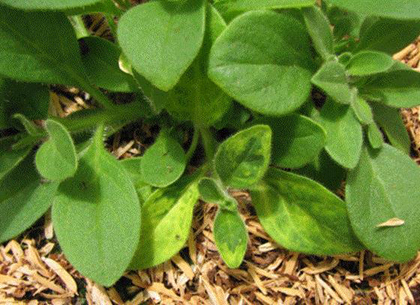Here’s a helpful tech sheet from the Ball Seed Technical Services team detailing strategies for minimizing the risk of Tobacco Mosaic Virus (TMV) in your greenhouse.
PROBLEM: If presence of TMV or another Tobamovirus is confirmed in your operation via an ELISA (enzyme-linked immunoassay) test, use the following steps to minimize risk spread to other healthy crops.

STEP-BY-STEP ACTION PLAN:
1. Isolate affected plants on the bench and restrict employee movement through the area. This will minimize the chance of mechanical spread via employees and/or tools and carts.
2. Stop all unrooted cutting (URC) sticking operations until the sticking area can be cleaned and sanitized. Use the cleanup and sanitation procedure outlined below before you resume.
3. Bag plants that show symptoms or have tested positive for TMV where they sit in the greenhouse and throw them away ASAP.
• During this process, employees should wear disposable gloves, aprons, and/or Tyvek suits; throw away disposable articles after plants are dumped and change into clean clothing.
• Do not compost infected plants or save/reuse growing media.
• Do not transport unbagged plant material through your greenhouses or operational areas.
• Do not leave open-top dump bins with infected material on your grounds.
4. Use the procedure outlined below to thoroughly clean and sanitize both greenhouse and operational areas where infected plant material resided or was handled.
5. Resume normal operations once cleanup and sanitation are completed.
• Scout rigorously for TMV symptoms in any crops returned to the affected area. Here are some SYMPTOM PHOTOS FOR REFERENCE.
• Continue to scout crops in other areas for TMV, in case disease was transmitted elsewhere.
Cleanup & Sanitation
1. Thoroughly sweep or shop-vac the area to remove as much plant debris, growing media and other organic matter as possible. Also remove any weeds.
2. Wash surfaces, greenhouse carts and other equipment that infected plants touched with water and a detergent or cleaner.
• Use of a pressure washer and cleaning agent (ex. StripIt Pro) during this step is advisable.
• Follow all label instructions! Especially if the cleaning agent should not be applied to certain materials or if an additional rinse pass is needed.
3. Allow washed surfaces to dry completely. Then apply one of the following sanitizers:
• Virkon Greenhouse (1% w/vol solution; follow mixing instructions for quaternary ammonia-based sanitizer (ex. KleenGrow, Green-Shield II, Physan).
• 1:10 dilution of household bleach (at least 5% sodium hypochlorite)
• 20% solution of nonfat dry milk in water (wt/volume) Note: Soak any transplanting tools or utensils.
Scout all incoming material by looking for symptoms. The symptoms of TMV can vary depending on the host, cultivar or isolate of TMV. Common symptoms may include mosaic patterns on leaves/flowers and distorted growth. Plants can also be asymptomatic. Use IMMUNOSTRIPS to confirm whether “suspect” symptomatic plants are positive for the virus. TMV Immunostrips detect more than just TMV, so use a diagnostic lab to determine the specific virus.
Dispose of suspect or positive plants with gloves and garbage bags at the bench. Sanitize the area where the plant was with 0.6% sodium hypochlorite or Virkon. If petunia or calibrachoa plants test positive in a mix, do not replant with another solanaceous plant.
Stick cuttings by the bag, which likely includes 100 cuttings, and keep the farm tag with those cuttings for traceback. Mixing bags within a tray will complicate traceback and diagnosis of issues.
How to prevent TMV from entering the greenhouse on people. Require all workers handling plants to wash their hands with soap and water before and after handling plants. Limit workers who use tobacco products from handling solanaceous crops like petunia and calibrachoa.
How to prevent the spread of TMV. Understanding how the virus is transmitted helps you prevent the spread of TMV. Like other Tobamoviruses, TMV is mechanically transmitted. Infected plant sap can transmit the virus from plant to plant via hands, tools and clothing. Standard production practices and handling, activities such as pruning, transplanting, sticking and pinching, can spread TMV.
Treat tools with a 1:10 dilution of household bleach (0.6% sodium hypochlorite). Virkon S or 20% non-fat dry milk are also recommended. Thoroughly clean all mechanical trimmers or pruners of plant debris and soak with Virkon, bleach or quaternary ammonium for a minimum of 10 minutes. The effectiveness of these products is reduced if contaminated with soil or large amounts of plant debris. Pinching plants is an easy way for sap from infected plants to spread infection in a greenhouse. Unfortunately, ethyl alcohol and other alcohol-based hand sanitizers will NOT deactivate TMV. Wearing gloves and regularly sanitizing with 0.6% sodium hypochlorite or washing bare hands regularly with soap and water while working in the greenhouses is advised.
As the virus can persist on plant debris, end-of-season greenhouse cleanout is essential. Remove plant and soil debris from pots, benches and floors and follow instructions for cleaning and disinfecting.
Check out this excellent resource from UMass for more DISINFECTION PROTOCOLS.